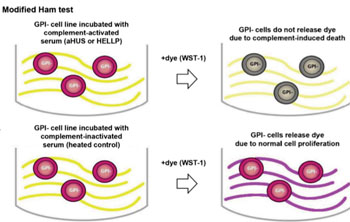Blood Test Advances Diagnosis Of HELLP Syndrome
By LabMedica International staff writers
Posted on 01 Jun 2016
A laboratory blood test for the diagnosis of a rare genetic red blood cell disorder also shows promise in identifying HELLP syndrome, a life-threatening high blood pressure condition affecting 1% of all pregnant women.Posted on 01 Jun 2016
HELLP is an acronym for hemolysis, elevated liver enzymes and low platelets and is a severe variant of pre-eclampsia whose pathogenesis remains unclear. Recent evidence and clinical similarities suggest a link to atypical hemolytic uremic syndrome, a disease of excessive activation of the alternative complement.

Image: A model of the principle underlying the modified Ham test (Photo courtesy of Johns Hopkins University).
Scientists at Johns Hopkins University School of Medicine (Baltimore, MD, USA) used the modified Ham test to study serum samples from 14 women with classic or atypical HELLP syndrome, seven women with severe preeclampsia, 11 women with normal pregnancies, and eight healthy non-pregnant women. All pregnant women were at least 23 weeks pregnant.
Serum Complement C5b-9 Membrane Attack Complex levels were determined using a commercially available enzyme-linked immunosorbent assay (ELISA) kit (Quidel, San Diego, CA, USA). The modified Ham test reflects complement activation as a percentage of complement-mediated cell-killing and is thereby a functional assay. The modified Ham test was measured in an iMark Microplate Absorbance Reader (Bio-Rad, Hercules, CA, USA) at 490 nm with a reference wavelength at 595 nm.
The investigators found increased complement activation, as measured by the modified Ham test, in women with classic or atypical HELLP, compared to those with normal pregnancies or those not pregnant. They observed average cell killing of 34.3% in those with classic HELLP, and 26% in atypical HELLP compared to an average 5% in those with normal pregnancies and 3.3% in those who were not pregnant. They also found that mixing serum from women with classic or atypical HELLP together with a monoclonal antibody that blocks complement, resulted in a significant decrease in the killing of cells in the modified Ham test, from about a 34% kill rate down to a 5% kill rate, the amount seen in healthy individuals.
Arthur J. Vaught, MD, a maternal fetal medicine fellow and lead author of the study said, “The clinical implications from an obstetric point of view are potentially huge. If this works, we can reduce pre-term deliveries, stays in the neonatal intensive care unit and other complications for mothers and their babies. This assay may aid in the diagnosis of HELLP syndrome and could confirm that its pathophysiology is related to that of atypical hemolytic uremic syndrome.” The study was published in the May 2016 issue of the journal Experimental Hematology.
Related Links:
Johns Hopkins University School of Medicine
Quidel
Bio-Rad








 (3) (1).png)





